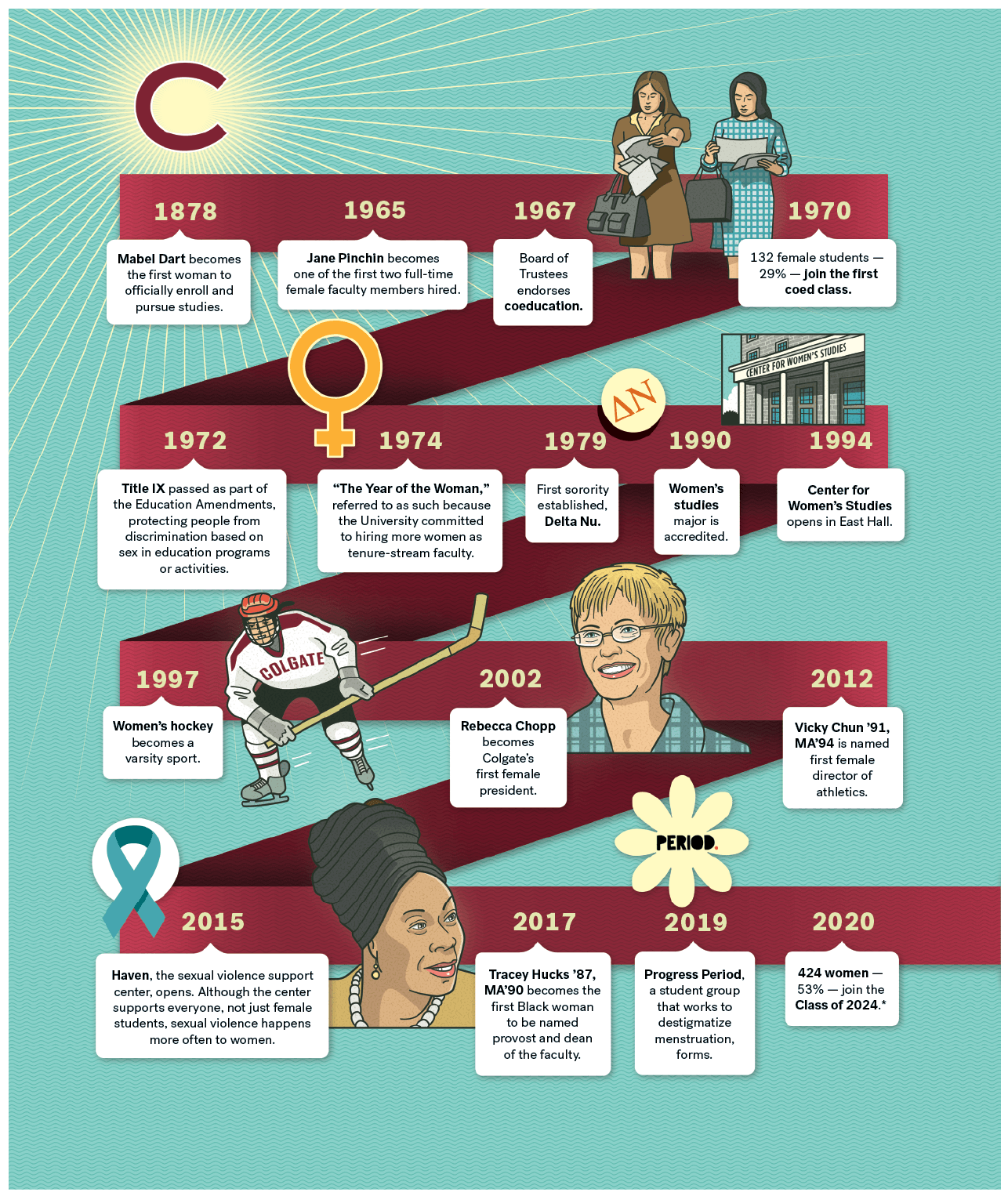Meaningful moments for women in Colgate’s history and a glimpse into the future
Illustrations by Peter Hoey
Click here to view timeline as text
In the fall of 1964, Dean of Students William Griffith commented that both the curricula and activities at coeducational institutions were slanted in favor of male students. In these colleges, “90 per cent of student body presidents and student leaders are men,” he told the Maroon in an article debating Colgate’s coeducational future. In his opinion, “equal opportunities for both sexes in the university” was not a realistic goal.
When Colgate’s first female class did join the student body in 1970, the women didn’t bat an eyelash about becoming key members of organizations and starting their own initiatives to enrich their experiences. Today, the list of numerous female student leaders at the University includes two editors-in-chief of the Maroon-News, the SGA president, three women leading WRCU, and several others who have started new groups to bring about change.
As we recognize the pivotal events that have given women a seat at the University’s table, we also introduce three current student leaders who are working to make Colgate a better place for all.
Taking the lead
Jaritza Núñez ’21

Núñez worked for the ALANA Cultural Center as an ambassador during her first two years; and she became an ALANA social justice peer educator as a junior.
She is an Office of Undergraduate Studies Scholar, a partner of Colgate Student Coalition, a cofounder of Colgate’s Unheard (increasing BIPOC artists/voices), a coleader and social chair of We Are Enough (a community of low-income Colgate members), the social chair for LAMBDA (queer student organization), and a member of Link staff. “I want to create a more inclusive Colgate where members of underrepresented groups can not only survive, but thrive,” she says.
A sociology and educational studies major from Lamont, Calif., Núñez will also work as a senior intern for the Office of Admission this spring.
Keelah Dixon ’21

“To further analyze societal oppression and its consequences,” Dixon designed a topical major in natural science and mathematics. In her studies, she examines how to bridge an analysis of multidimensional oppression through mathematical means.
A women’s basketball player, Dixon works closely with varsity athletics and the ALANA Cultural Center. She is an ambassador for Raiders of Color Connect, the vice president of Athletics Wellness Advocates, and Colgate’s student representative for the Patriot League Anti-Racism Commission.
Hailing from Boston, Mass., Dixon is an ambassador for Shaw Wellness, a Bystander Intervention facilitator, and a member of Konosioni. “I want to make a better environment for students and community members,” she says, “especially those who have unique identities and come from marginalized communities.”
Flora Zhang ’22

As the copresident of the Organization of Asian Sisters in Solidarity (OASIS+) and the Minority Association for Premedical Students (MAPS), Zhang’s “goal is to provide support and space for traditionally underrepresented students to voice what they need on campus,” she says.
“OASIS+ and MAPS became spaces where I felt comfortable to be entirely myself as both a student of color and first-generation college student,” she says. “I found an incredible amount of support, love, and mentorship from these clubs, so I applied for leadership positions to ensure that these safe spaces and resources continue.”
Zhang is a molecular biology and women’s studies major from San Francisco who is also part of the Link staff, First Generation Initiative, and Sipsam dance group.
- 1878: Mabel Dart becomes the first woman to officially enroll and pursue studies.
- 1965: Jane Pinchin becomes one of the first two full-time female faculty members hired.
- 1967: Board of Trustees endorses coeducation.
- 1970: 132 female students — 29% — join the first coed class.
- 1972: Title IX passed as part of the Education Amendments, protecting people from discrimination based on sex in education programs or activities.
- 1974: “The Year of the Woman,” referred to as such because the University committed to hiring more women as tenure-stream faculty.
- 1979: First sorority established, Delta Nu.
- 1990: Women’s studies major is accredited.
- 1994: Center for Women’s Studies opens in East Hall.
- 1997: Women’s hockey becomes a varsity sport.
- 2002: Rebecca Chopp becomes Colgate’s first female president.
- 2012: Vicky Chun ’91, MA’94 is named first female director of athletics.
- 2015: Haven, the sexual violence support center, opens. Although the center supports everyone, not just female students, sexual violence happens more often to women.
- 2017: Tracey Hucks ’87, MA’90 becomes the first Black woman to be named provost and dean of the faculty.
- 2019: Progress Period, a student group that works to destigmatize menstruation, forms.
- 2020: 424 women — 53% — join the Class of 2024 (as of June 1, 2020)

